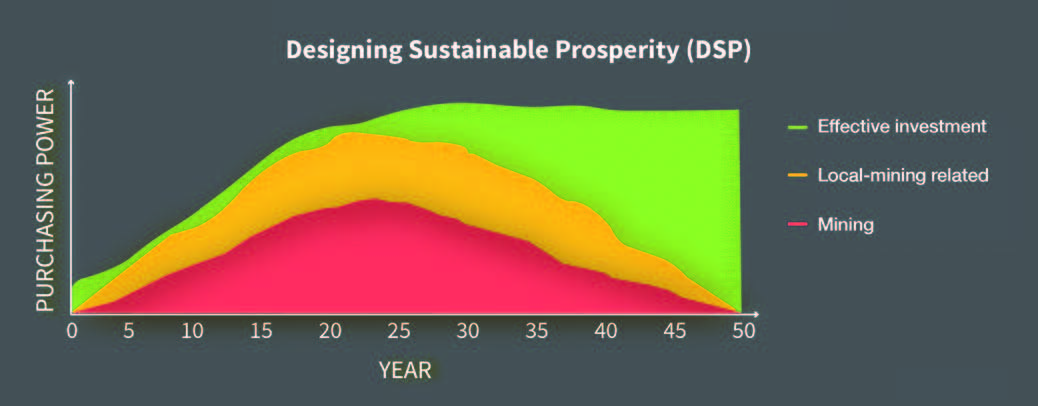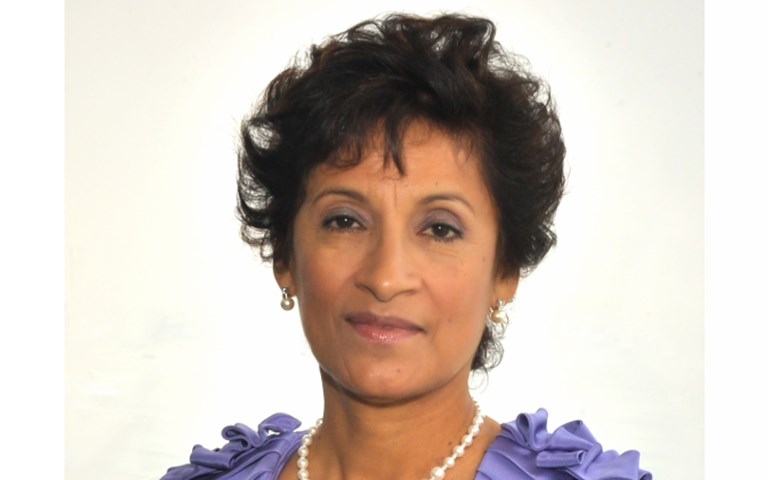The development and operation of a mine results in several years of intense activity followed by the dramatic reduction of employment and opportunities after the mine is closed. Designing Sustainable Prosperity (DSP) is a method for mining companies to improve this situation by designing for long-term growth in a mine’s region. If successful, vibrant, long-lasting businesses should be the result for the regions affected by mining.
The objective of DSP is to establish diverse and innovative industries in mining-dominated regions, which have a significant positive impact on the communities and are not dependent on any single commodity. These industries are not necessarily associated with mining and to be effective will have to successfully compete in the global market while striving to reduce their environmental impact. During the DSP process, the mining company transitions from the sole provider of employment to a catalyst for regional development.
DSP uses multidiscipline skills to design solutions, services, products and technologies that will be needed in the future based on a region’s natural resources, possible energy sources, infrastructure needs and solutions for waste. Sustainable prosperity is a long-term effort requiring substantial initial planning. It requires collaboration between local communities, national governments, industry, financiers, engineers and scientists.
Implementing DSP
The concept of DSP uses engineering principles to determine the attributes of a region by integrating community aspirations and market conditions with the available skill sets. The initial framework must be established early in the mine life to ensure that the appropriate education and skills training is carried out to enable appropriate sustainable regional development upon mine closure.
 Figure 1 illustrates the investment, and thus purchasing power, in a mining-dominated region. Red represents the lifespan of a mine and yellow the associated mining-related services. These represent the norm in a mining region over the life of a mine; purchasing power ultimately returning to near-zero. Green represents the implementation of DSP; as can be seen over time (the life of mine), the economy becomes diversified and the purchasing power maintained.
Figure 1 illustrates the investment, and thus purchasing power, in a mining-dominated region. Red represents the lifespan of a mine and yellow the associated mining-related services. These represent the norm in a mining region over the life of a mine; purchasing power ultimately returning to near-zero. Green represents the implementation of DSP; as can be seen over time (the life of mine), the economy becomes diversified and the purchasing power maintained.
– Designing Sustainable Prosperity “DSP”: A collaborative effort to build resilience in mining producing regions, by D. Hiam-Galvez, F. Prescott, and J. Hiam, CIM Journal, Vol. 11 No. 1
To build a sustainable economy, the following key elements are required:
» There must be a potential for economic development for the region: DSP starts by looking at the region’s natural resources and skills available, the infrastructure and possible energy sources using integrated natural resource models, followed by education and skills requirements, to determine the potential for the region and what needs to be done to realize the possibilities.
» There must be a potential market for the intended products or services: Innovative market studies need to evaluate the potential market for products, services or industries that the region could serve competitively and globally beyond the life of mine.
» The potential identified and designed DSP: Once the potential and the market have been established, create a plan for how to realize the potential.
» There needs to be a champion who knows what it takes to make it happen and is capable of implementing this strategy. Without key leaders with the right vision and skills to motivate and drive efforts, the plan will languish.
» The appropriate stakeholders must be brought to the table: Bringing along key stakeholders during the whole DSP process will help achieve buy-in. Involving them in all areas of the design from data collection to analysis, etc., will help identify champions to ensure implementation is successful.
DSP is built around the tenet that comprehensive community involvement during all stages of mine development can lead to a more diversified economy. The community can develop their future, aided by diverse investments that arise from the presence of the mine but are not driven by the mine. This links the future of the communities with the mines, ensuring a timely and beneficial licence to operate. The process creates a collaborative environment that maximizes benefits to communities and others while minimizing impacts.
Government plays a key role in providing incentives for investors to come to the region, by investing in infrastructure, and by providing flexibility to adapt the education system to accelerate the development of skills and tools to support a diverse economy and build long lasting business.
DSP in the copper-mining regions of Peru and Chile
Natural resource-rich regions are vulnerable to the volatility of economic activity depending on the global demand of the natural resources. By applying the principles of DSP, we can get away from this volatility of activity by broadening and diversifying the economy.
There is a potential to grow long-lasting businesses in the economies of Peru and Chile, where more than 40 per cent of copper concentrates in the world are produced. The region faces two challenges: local economies that will have considerable trouble surviving when mining activity ends and the severe water shortage expected within 10 years.
However, the region also has the best solar energy potential in the world. There is an opportunity to focus on improving solar technology to use as an economic source of energy for sea water desalination. Desalinated water, produced in quantities beyond that required for mining, can then enable sustainable agriculture to be established. This in turn creates the opportunity to develop processed and unique food products for the global market. As a centre of excellence in the desalination of sea water with solar energy, the region can then export that knowledge. Once we visualize the potential of the region and determine what innovative industries could be built, the education system needs to be adapted to develop the skills and tools to support these diversified industries.
In 30 to 50 years the copper-mining regions of Peru and Chile could have, for example, 25 per cent of their economy dependent on the strong growth of sophisticated technologies for desalination of sea water with solar energy, as well as innovative food products; 50 per cent of their economy dependant on mining (which follows the boom and bust cycles, as do most natural resources); and 25 per cent of the economy dependent on the services to support both groups of growth (strong and boom-and-bust).
DSP, when implemented, enables economies previously considered to have no long-term future to successfully diversify to the benefit of the local people and the world in general.
You can read the technical paper, “Designing Sustainable Prosperity ‘DSP’: A collaborative effort to build resilience in mining producing regions,” by D. Hiam-Galvez, F. Prescott, and J. Hiam in CIM Journal, Vol. 11 No. 1. To ensure you can access this CIM Member benefit, log in to your CIM account.
Doris Hiam-Galvez is Director, Metals at Hatch.





